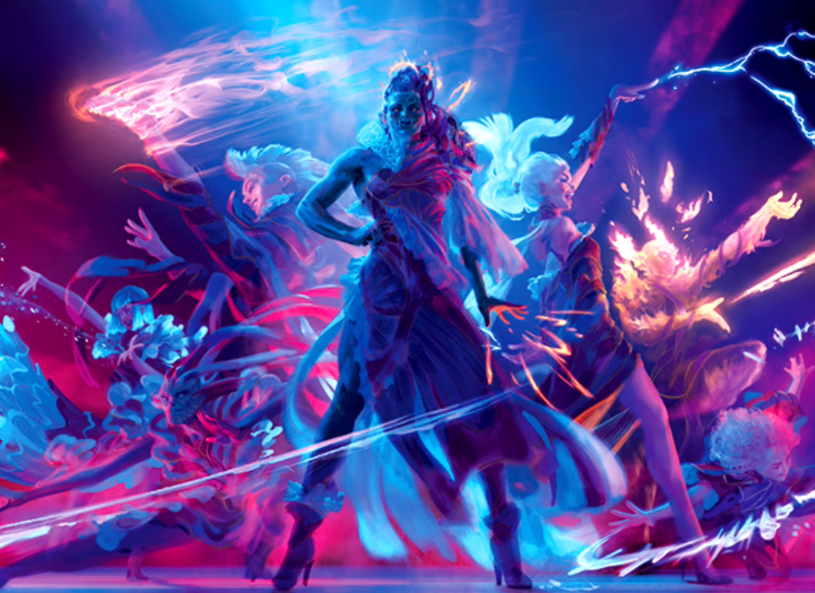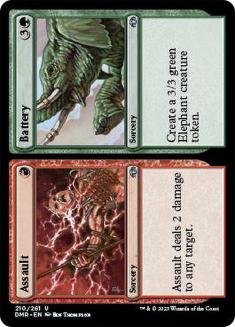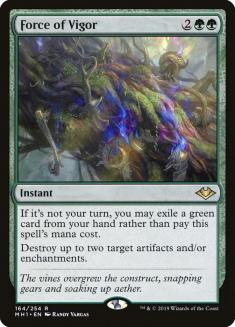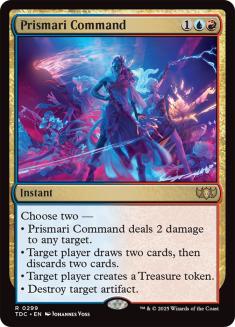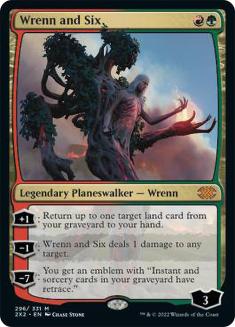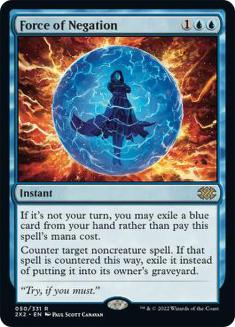Love it or hate it, Mono-White Hammer is the deck to beat in Modern.
Creatures (24)
Lands (20)
Spells (16)

I’ve seen a lot of great players picking up this monstrosity and running circles around their opponents, including our own illustrious editor Cedric Phillips. It’s as complicated as Infect, and is just as lethal. It attacks from multiple angles, and can even weather a storm of artifact or creature destruction. It can fight through spot removal for days, and dodges sweeper effects thanks to Inkmoth Nexus. There’s much to love about Mono-White Hammer (Lurrus), but this style of deck is not for everyone.
If you’re like me, you enjoy poking holes in strategies instead of picking up the “best deck.” There are quite a few cards that directly attack this strategy, and a number of archetypes that can use them. Today’s article will focus on how we can beat Mono-White Hammer in a few different ways while focusing on the specific cards that give us that boost. First on the list is one I’ve talked about before, but we’re dredging it back up because it’s an absolute monster against the best deck in the format.
Fury
Of all the pitch Elementals in Modern Horizons 2, Fury was close to the bottom of my list because there weren’t a lot of creature-based strategies running around. It was usually trading down on raw resources, but there were so many creatureless decks that it just felt underwhelming. Even if your opponent played a Stoneforge Mystic or something, you needed to trade two cards in your hand to kill it before Kaldra Compleat entered the fray. Nowadays there are so many creatures running around that it’s hard not to get a double kill.
Fury, like Pyrokenesis before it, thrives against archetypes that explode onto the battlefield. In a format that’s dense with noncreature spells, cards like Fury or Pyrokenesis are usually relegated to the sideboard. When the format becomes more creature dense, either with combos revolving around creatures or decks just playing more to the battlefield in the early turns, we can move cards like Fury from the sideboard to the maindeck to great effect. Now that we know Fury is good, all we have to do is find the right home for it.
I’ve written about Fury in the maindeck of Temur Crashcade before, with an emphasis on how you need to construct your deck with more red spells in order to facilitate the evoke cost. Split cards like Assault // Battery give you some freedom to move numbers around because they count for both Endurance and Fury. Fire // Ice helps with Force of Negation, Subtlety, and Fury. Playing split cards that can get around the cascade mechanic while also providing you multiple colors and cheap interaction is the exact type of thing we’re looking for.
Since Mono-White Hammer plays so many cheap/free creatures, traditional spot removal isn’t all that great against them. Fatal Push and Lightning Bolt can only trade one-for-one, but a card like Fury can sweep them off their feet. You have to be aggressive when clearing their side of the battlefield because any creature can carry a Colossus Hammer. If you let anything survive, a single Colossus Hammer equip threatens to end the game. It’s only through brute force that we can stifle their development and ensure Colossus Hammer never gets equipped.
Creatures (14)
Lands (23)
Spells (23)
- 4 Violent Outburst
- 4 Assault
- 4 Fire
- 4 Force of Negation
- 4 Crashing Footfalls
- 1 Sea Gate Restoration
- 2 Prismari Command
Sideboard

Assault // Battery is a great way to interact early while providing you with a pitch card for Fury, Endurance, and Force of Vigor. With eight green pitch cards in the sideboard, it’s important to keep your green count high, and I’ve chosen Assault // Battery over Dead // Gone to help with that. I’ve also slightly reduced the number of Bonecrusher Giants because it functions on a similar wavelength to Assault but costs one more mana. You need to diversify your interaction a little bit, so having a bunch of cards that just deal two damage is less desirable than mixing and matching between Brazen Borrower and the like.
The best part about Crashcade is that the “combo” doesn’t require you to play a ton of weirdo cards. That means our deck gets to be highly interactive, even if that interaction isn’t exactly the most efficient. We must find unique cards that can fit the mold of “cheap but dodges cascade,” but any type of interaction is good against Mono-White Hammer. All their creatures are tiny, so the scaling of Lightning Bolt versus Assault is not too relevant here. We also don’t have much of a choice!
Force of Vigor
Of all the sideboard cards we have access to, Force of Vigor is the most important. Turning it on by playing enough green cards will turn it from good to great in the matchups where you desperately need to interact. Mono-White Hammer has so many targets that all you want is something that can pop off a permanent or two for very little mana. There’s been a rise in Ancient Grudge numbers to mirror this sentiment, but Force of Vigor is arguably the most brutal tool in the format against this archetype.
When combined with the power of Fury, Force of Vigor should clean up most messes the Hammer deck could produce. Equipment have a way of sticking around after you kill all your opponent’s creatures. The Hammer deck does a great job of finding more bodies to equip them to. Just killing your opponent’s creatures won’t be good enough a majority of the time. We need to apply intense pressure with Crashing Footfalls while also chopping down their better artifacts or enchantments. Hitting them on all three fronts (creatures, artifacts, and pressure) is the key to victory.
Prismari Command
Like Kolaghan’s Command, which we talked about last week in our sideboard guide of Rakdos Midrange (Lurrus), Prismari Command can tag a creature and artifact at the same time. When a card can do that, it tends to be quite good against decks like Infect or Mono-White Hammer because their creatures are small and their deck is full of artifact targets. Prismari Command also shines for its ability to be pitched to Force of Negation and Fury, two cards that are almost pure opposites in how they interact but both need a high number of pitch enablers.
Prismari Command is also great for helping churn through our deck for specific answers or cascade cards. Since we’re not playing four colors with twelve cascade cards, we have to stall our opponent a bit longer than normal while we find our payoffs. That’s not a bad prospect because our combo doesn’t define us. We don’t win or lose based on whether or not we draw Violent Ourburst. Instead, our generation of Rhinos helps reinforce the strength of our interaction. In some matchups, making Rhinos from Crashing Footfalls isn’t even necessary.
I like that Prismari Command can generate a Treasure in a pinch. Fully casting a card like Fury is outrageous. The body is big, it hits hard, and it can’t be blocked very well. Ramping up to five mana off Prismari Command while killing an opposing artifact or creature is just another stepping stone this deck can use to get a leg up. Cards like Prismari Command shine when your deck can successfully use every mode, and I think this deck does a spectacular job of doing exactly that.
It’s Elemental, My Dear Watson
Our goal is to find a home for Fury. That means we have to explore all the options available to us. This past weekend, Kanister went pretty hard with an Elemental build that successfully used Fury to dumpster all his opponents in the Modern Challenge. Here’s the list:
Creatures (21)
Planeswalkers (6)
Lands (22)
Spells (11)

I’ve seen a lot of people trying out Elemental shells with the new mythic Elemental Incarnations. Getting a free card off Risen Reef is ridiculous, as it counteracts the negative card economy used to fuel the free costs. We all know by now just how good the Elemental Incarnations are, so any shell that gets to play a ton of them and can aggressively counteract their cost is worth a second look. Ephemerate is also quite strong with most of the Elementals, as they naturally have enters-the-battlefield effects which can be exploited by the one-mana instant. Using Ephemerate with the pitch evoke cost is a great way to overwhelm an opponent who is lacking interaction.
Solitude
Solitude just so happens to be an excellent card against Mono-White Hammer. This deck combines that strong effect with Ephemerate, which can decimate a creature-based opponent if they aren’t careful. Without removal or much interaction at all, Mono-White Hammer struggles against this pairing. It provides the caster with so much interaction that it can singlehandedly take the wind out of your opponent’s sails.
When they move all-in on something like Inkmoth Nexus, a single Solitude while tapped out can counteract their killshot. Once you take away that window of opportunity to kill, you’ve effectively sapped their time and resources for a very small investment. Getting to untap after successfully defending the killshot is one of the best feelings in the world.
Wrenn and Six
Wrenn and Six also excels against Mono-White Hammer. Many of their creatures have one toughness, and picking off the lackluster ones while your traditional removal takes care of their important threats is key for ensuring that Colossus Hammer doesn’t get to stick on anything. Wrenn and Six also helps this deck hit all its land drops, which is important when we’re low on resources from evoking our Incarnations.
Wrenn and Six is one of those cards that’s obviously great but currently underplayed. I expected to see a lot more of it running around over the last few weeks, if only because it tags Ragavan and early Dragon’s Rage Channelers. It seeing more play now is a direct result of the popularity of Mono-White Hammer and I expect that trend to continue.
Force of Negation
I like moving Force of Negation to the sideboard. There are obviously a lot of hits in Modern, but many archetypes are using creatures to do most of the heavy lifting while the noncreature spells are just utility and interaction. Force of Negation thrives against expensive noncreature spells. It strips a combo deck of its payoff; stops a Teferi, Hero of Dominaria in its tracks; and feasts on Bring to Light. Moving Force of Negation to the sideboard is a statement.
Some decks still need to play Force of Negation because of their vulnerabilities. For example, Temur Crashcade can’t really beat an opposing Teferi, Time Raveler. Elementals has fewer inherent weaknesses, but requires a bit more time to get the engine running. If the average opponent isn’t trying to kill you within the first four turns, cards like Force of Negation aren’t as important. It’s also noteworthy that this maindeck doesn’t play many blue cards, so trying to jam Force of Negation into it is likely a mistake.
The Elemental Incarnations and other pitch spells offer some unique hurdles in deckbuilding. You need to take your spells into consideration when building your manabase, but now you need to do the same with colored spells and your Incarnations/Forces.
Shattered Dreams
If you want to thrive in a format full of Mono-White Hammer (Lurrus), your goal should be to maximize interaction. As an Infect player, let me just say that the most frustrating games of Magic to play were the ones where my opponent hit my hand with discard and my creatures with removal. Being attacked on two different axes can be difficult to overcome for a deck like Infect, and the same is true for the Hammer decks.
With that said, the other angle of attack shouldn’t be discard. In fact, because of Urza’s Saga, discard effects are trash against Hammer decks. You need to be killing their creatures and their artifacts over and over. That’s why Force of Vigor and Ancient Grudge are so good. That’s why Fury is excellent. If you can overwhelm them by killing all their relevant permanents, and even some of their irrelevant ones, where else can they go? If you leave them with no copies of Colossus Hammer and a handful of Memnites and Ornithopters, what is their gameplan exactly?
Their deck is good; perhaps very good; maybe even great. However, Modern offers plenty of ways to interact with all sorts of permanents in aggressive and cheap ways. Right now, the Hammer decks offer up a simple problem: kill a bunch of artifacts and creatures or else you die. Finding the right cards to help against that is difficult, and figuring out the best shells for those cards to shine will result in some major success. At the moment, the decks that are winning are the ones playing or beating Colossus Hammer.
Choose your champion accordingly.

